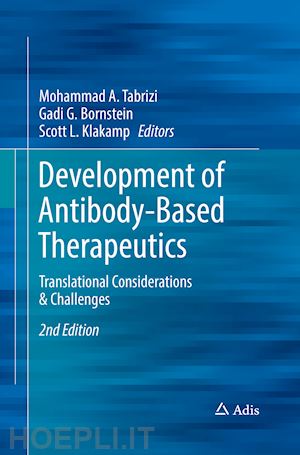
Questo prodotto usufruisce delle SPEDIZIONI GRATIS
selezionando l'opzione Corriere Veloce in fase di ordine.
Pagabile anche con Carta della cultura giovani e del merito, 18App Bonus Cultura e Carta del Docente
1. Introduction.- 2. Translational Considerations and Challenges: An Overview.- 3. Considerations for Construct and Affinity Design Goals.- 4. Epitope Characterization and Isotype Selection.- 5. Biophysical Considerations for Development of Antibody-Based Therapeutics.- 6. Novel Technologies for Generation of Bispecific Constructs.- 7. Stimulus-Response Mechanisms: An Overview.- 8. Evaluation of Tumor Growth Inhibition in Preclinical Tumor Models –A Quantitative Approach.- 9. Application of Proof-of-Mechanism Biomarkers (POM) in Design and Development of Biologics Modalities.- 10. Antibody Drug Conjugates: Translational Considerations.- 11. Application of PK-PD Modeling and Simulation Approaches for Immuno-Oncology Drugs.- 12. Translational Biomarkers: Application in the Clinical Development of Combination Therapies.
Mohammad A. Tabrizi, Ph.D. is a leader in translational sciences as related to development of antibody-based therapeutics. His product development experience spans many therapeutic areas including oncology and inflammatory disease, and his technical expertise includes preclinical pharmacology and safety, preclinical and clinical pharmacokinetics, pharmacodynamics, GLP-compliant bioanalytics, and clinical pharmacology of therapeutic monoclonal antibodies.
Following his postdoctoral training, Dr. Bornstein joined Amgen Fremont, Inc. (formerly Abgenix, Inc.) as a Staff Scientist in the Preclinical Oncology department. Dr. Bornstein has held roles of increasing responsibility at AstraZeneca, Pfizer, and Novartis, where he was a project team leader, lead biologist, and key contributor to scientific strategies for multiple oncology programs. Dr. Bornstein has authored numerous research papers, reviews, as well as book chapters, and is a co-inventor on multiple patents.
Scott L. Klakamp, Ph.D. is one of the leading scientists in utilizing Surface Plasmon Resonance (SPR) and KinExA® to measure the binding kinetics and equilibrium dissociation constants of human monoclonal antibody/antigen complexes. He was the founder of SKD Consulting LLC and acted as Principal Consultant at that company during the development of this title. Prior to SKD Consulting LLC, he was the Vice President of Chemistry and Biochemistry at BiOptix Inc., a company that provided the 404pi biosensor. Dr. Klakamp has also held positions of increasing responsibility in the areas of analytical and biophysical characterization at Chiron, Amgen/Abgenix, AstraZeneca/MedImmune, and Takeda Pharmaceuticals. Dr. Klakamp has been an author on over 30 research and review papers, book chapters, and patents. He has also been an invited speaker at numerous international and national meetings. Dr. Klakamp received his B.A. in Chemistry from Houghton College and his PhD in Chemistry at the Pennsylvania State University. From 1990 to 1993, he completed a postdoctoral fellowship (funded by a National Research Service Award from the National Institutes of Health) at the California Institute of Technology in bioinorganic chemistry.










Il sito utilizza cookie ed altri strumenti di tracciamento che raccolgono informazioni dal dispositivo dell’utente. Oltre ai cookie tecnici ed analitici aggregati, strettamente necessari per il funzionamento di questo sito web, previo consenso dell’utente possono essere installati cookie di profilazione e marketing e cookie dei social media. Cliccando su “Accetto tutti i cookie” saranno attivate tutte le categorie di cookie. Per accettare solo deterninate categorie di cookie, cliccare invece su “Impostazioni cookie”. Chiudendo il banner o continuando a navigare saranno installati solo cookie tecnici. Per maggiori dettagli, consultare la Cookie Policy.